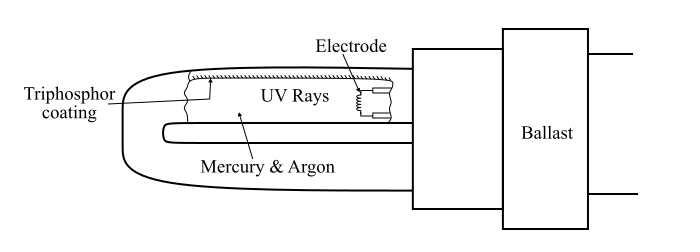
 Data Structure
Data Structure Networking
Networking RDBMS
RDBMS Operating System
Operating System Java
Java MS Excel
MS Excel iOS
iOS HTML
HTML CSS
CSS Android
Android Python
Python C Programming
C Programming C++
C++ C#
C# MongoDB
MongoDB MySQL
MySQL Javascript
Javascript PHP
PHP
- Selected Reading
- UPSC IAS Exams Notes
- Developer's Best Practices
- Questions and Answers
- Effective Resume Writing
- HR Interview Questions
- Computer Glossary
- Who is Who
Compact Fluorescent Lamp (CFL) – Construction, Working and Applications
A compact fluorescent lamp (CFL) is a type of fluorescent lamp that has been compressed into the size of an ordinary incandescent lamp. It works on the principle of gas discharge, i.e., ionization of gas by the electric current.
The modern CFL was invented by Edward E. Hammer in 1973.
CFLs are the lamps of choice for those looking for an energy efficient alternative to incandescent lamps.
CFLs consume very less power than an incandescent lamp.
The increasing variety of shape and color and small size of CFL have made them more versatile and acceptable than the conventional long tube fluorescent lamps.
Construction and Working of CFL
CFLs are widely used for residential as well as commercial lighting. The following figure shows the construction of a modern CFL −

A typical CFL consists of a gas filled tube with two electrodes mounted in an end cap. The tube contains a mixture of argon gas, mercury vapor and liquid mercury at low pressure. The tube is also coated on the inside with three different phosphors.
When the electric supply is connected to the electrodes, an electric arc is created between two electrodes. The electric arc produces the flow of electrons. When the mercury atoms inside the tube are bombarded by these electrons produce ultraviolet radiation. The phosphor coating inside the tube give off light when exposed to the UV radiation.
The circuit of the CFL contains a ballast which provides the high initial voltage required to create the starting arc and then limit the current to prevent the lamp from self-destruction.
Effect of Temperature on CFL Performance
The following characteristic curve shows the variation in the CFL output with the change in temperature.

From the graph, it is clear that the ambient temperature around a CFL can have significant effect on the light output and efficiency of the lamp. The optimum lamp wall temperature for a CFL is generally 38 °C.
At very low temperature, the light output from the CFL can decline to about 1/3rd of the rated value. Since at the temperatures below the optimum value, the mercury vapor will condense at cold spot, reducing the number of mercury atoms available to emit UV rays and hence the light output reduces.
Advantages of Compact Fluorescent Lamp
The main advantages of using a CFL are listed here −
CFLs are the energy efficient lamps. The operating cost of CFLs is very less. CFLs save a lot of electricity.
CFLs produce less heat as compared to incandescent bulbs.
The lamp efficiency of the CFL is fairly high, about 50 to 75 lumens per Watt.
CFL lamps do not require the starting gear. CFL lamps start immediately.
CFLs have longer lifespan.
Disadvantages of Compact Fluorescent Lamp (CFL)
The disadvantages of using a CFL are as follows -
The initial cost of installing CFL lamps is high.
CFLs are not environment friendly as they have mercury content.
CFLs can fail prematurely if overheated.
CFL lamps cannot be used with timer switches since these can reduce the lifespan of the CFL.

